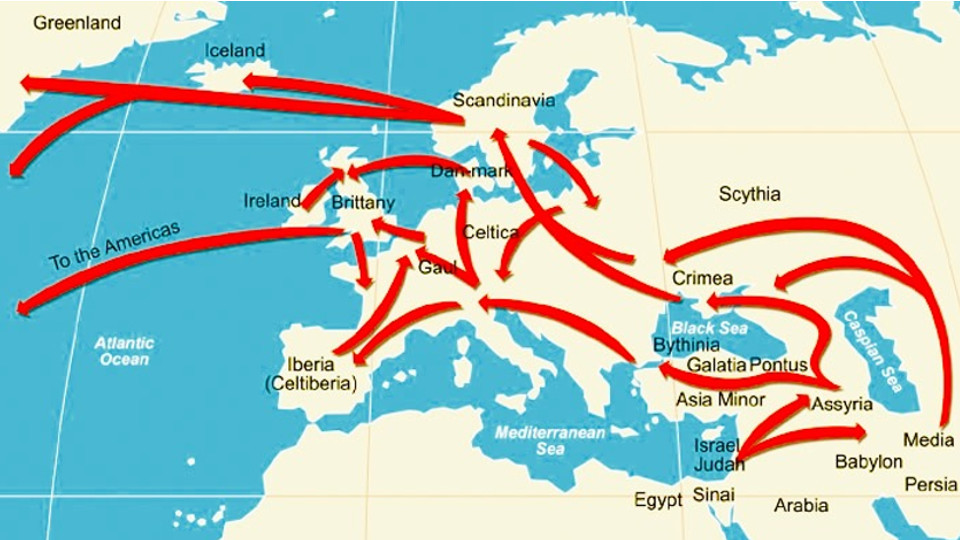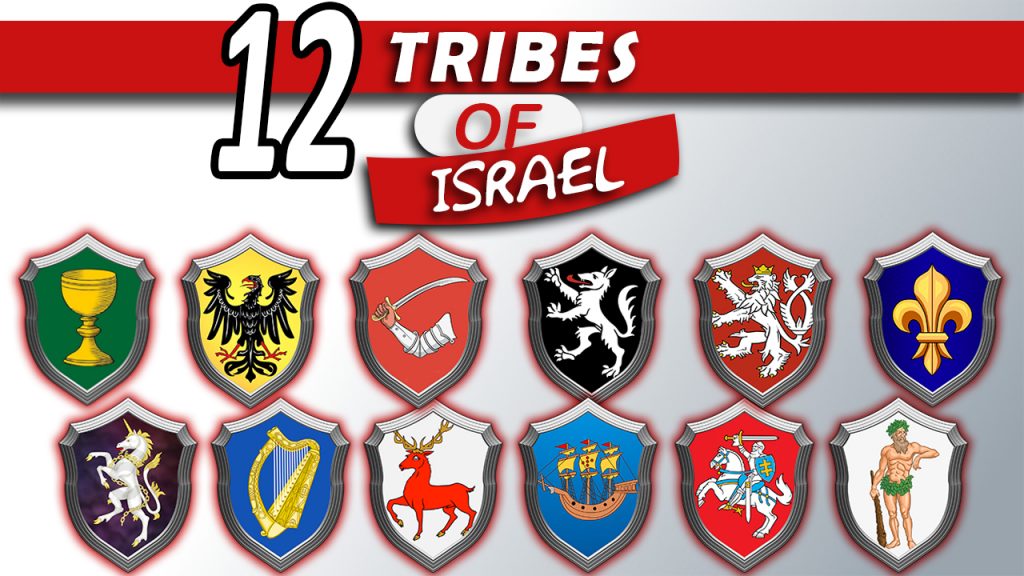100 Proofs The Israelites Were White - Part 10B
Proof 10B - The Bible Prophesied Israel would have a New Language
The Hebrew alphabet and sounds evolved to form English, and these slides will show how that happened. Our letters came from Hebrew and even to this day, we use the same linguistic sounds as our Hebrew ancestors did. This is not an accident. We naturally inherited their language because we are their descendants, true Israelites of true Israelites. We then expanded and improved upon our linguistic inheritance. Through this in-depth look at our alphabet, it will become obvious that the languages of other non-Adamic races did not come from Hebrew. Their languages have sounds that are not even present in our languages that evolved from Hebrew. This is yet another way in which we can clearly see that these races have a different origin from us. We are not all the same, linguistically or otherwise.
First, let’s go through the Hebrew alphabet letter by letter. It’s important to note that Hebrew had no written vowels. The vowels were embedded in the language itself, and as a result, we can say they were “hidden” because they were not explicitly written out. You just had to know how to pronounce a word. Let’s look at some examples.
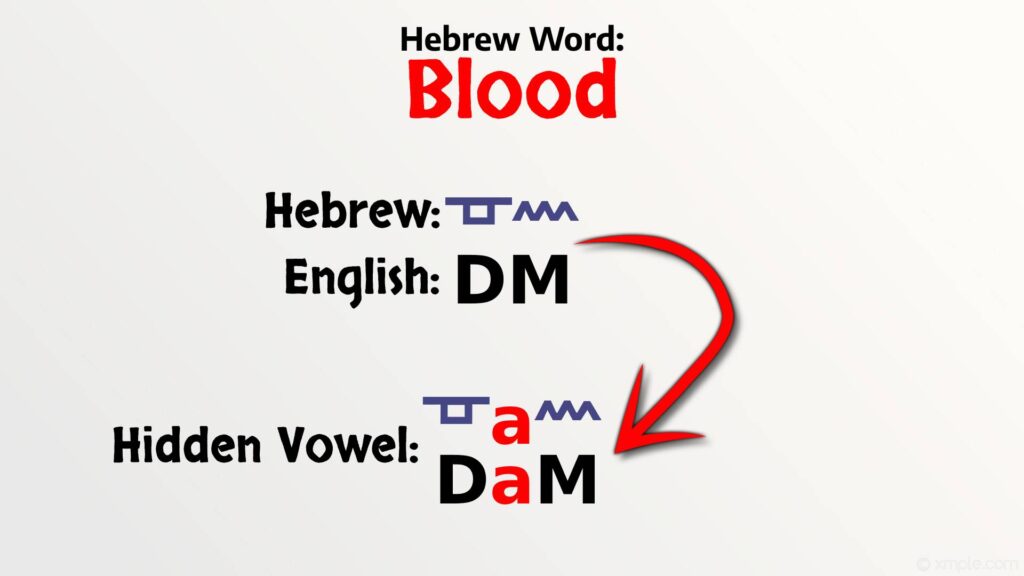
The Hebrew word for Blood was “Dam” which was spelled DM. There was no “a” vowel in the middle. Again, you just had to know how to pronounce the word.
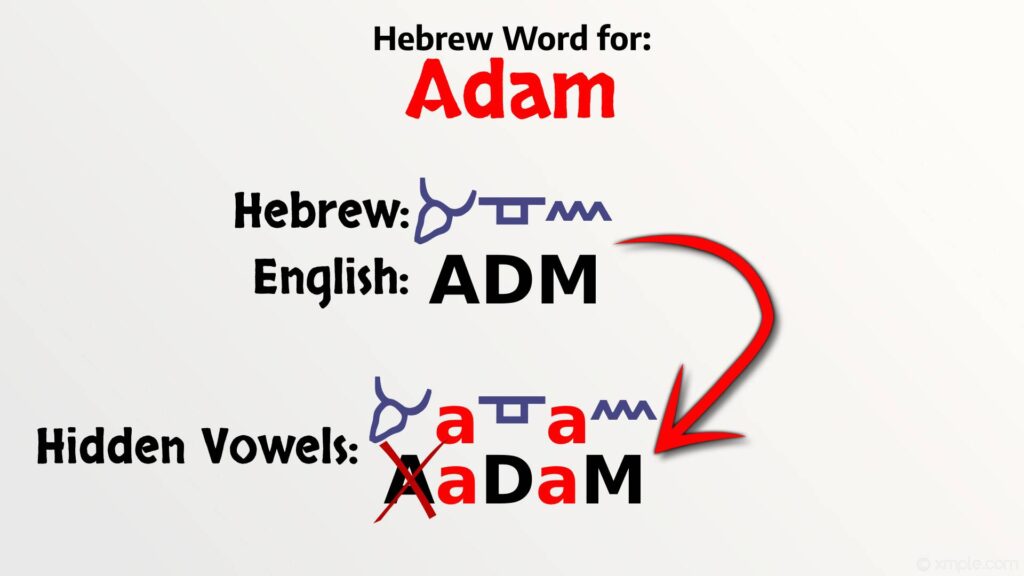
The name “Adam,” the first man, was spelled ADM. The “A” was actually silent, which we’ll explain more about soon. Suffice it to say for now that even this “A” was in fact a hidden vowel.
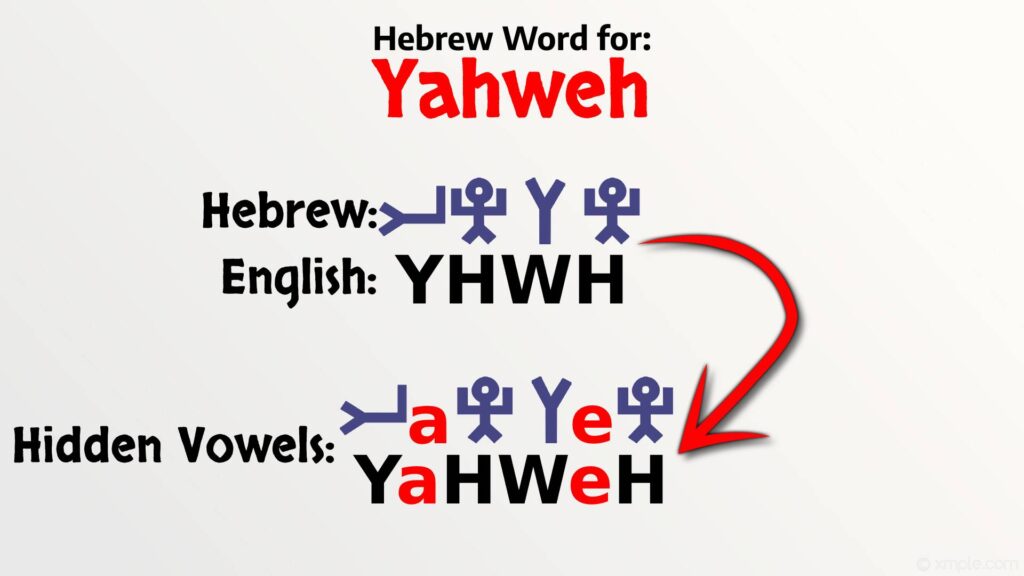
The name “Yahweh,” our God, the God of Israel was spelled YHWH. Again with no vowels. You would just have to know the “Yahweh” pronunciation.
Always keep in mind that our ancestors were slaves in Egypt and they did the best they could at the time. They didn’t have today’s luxuries. Their language and writing worked well enough for them, but as they spread out and became many nations, their language and writing necessarily developed and improved. Ultimately, Hebrew made vast leaps forward and formed English.
It’s interesting to note that Egyptian Hieroglyphs also lacked written vowels. In a similar way to ancient Hebrew, it was written in consonants. You would just have to know how to pronounce the words. This style of writing likely influenced the Hebrews when they developed the first-ever alphabet. Ultimately the Greeks, many of whom descended from migrating Israelites, took the Hebrew/Phoenician alphabet and began adding vowel letters to improve it. This is where some letters began to diverge from their original Hebrew sound and some sounds disappeared altogether. Different branches of European languages had different developments.
With this background about vowels in mind, let’s go through each letter one by one and trace the evolution of the letters and sounds in each European language. We will primarily be focusing on the evolution from Hebrew to English.
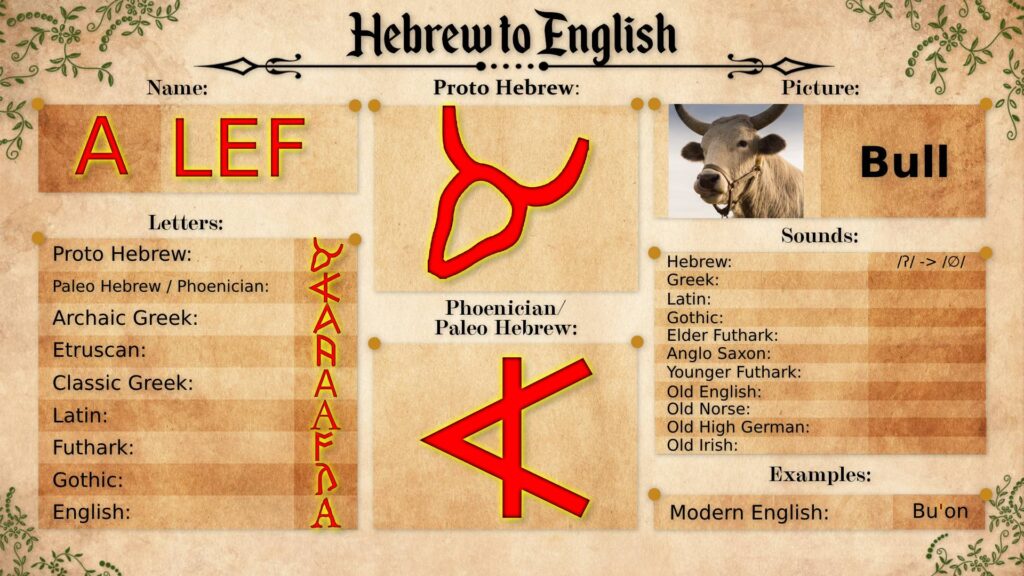
The first letter, Aleph, started out as a Bull’s Head. From there it got simplified to an upside-down “A” which still partly resembled a Bull’s head with horns and ears. Gradually it got turned sideways. Then the Greeks turned it upside down altogether in their Alpha letter and it became the way we write an A today. In Futhark it looked slightly like an F shape and in Gothic it was slightly different, but both Futhark and Gothic gradually adopted the Latin A.
Originally in Hebrew, the Aleph was silent. If it were at the beginning of a word, it would always represent a hidden vowel sound. But the Aleph also represented a Glottal Stop. The Glottal Stop is a brief interruption of the airflow while speaking. Think about the pause in the middle of the exclamation “uh-oh.” You don’t say “uhoh” as one continuous sound. Instead, you pause briefly in the middle. Today we still use Glottal Stops, although mostly unintentionally. For example, in numerous English dialects, the “t” gets turned into a Glottal Stop. For example instead of saying “button” or “butter,” the word gets shortened to “bu’on” and “bu’er,” where the “t” sound is barely produced. I myself am very guilty of doing this. Well, the letter Aleph in a word represents that brief pause.
So let’s look at several examples of Hebrew Glottal Stops. The World EL, which means God, is spelled Aleph and Lamed. When you combine Mem and Kap with EL, you get Mika’el, which we today pronounce Mikael or Michael. When you combine Yud, Shin, and Resh with EL, you get Yisra’el, which today we just pronounce Israel. But as an example of the Glottal Stop, Israel was originally pronounced Isra’el, and Mikael (Michael) was pronounced Mika’el. The apostrophe represents a Glottal Stop and its brief pause.
The actual word Aleph, which means cattle or oxen, was spelled ALP in Hebrew (Aleph, Lamed, Peh). The A is silent. So here you can see that it’s the hidden vowels that produce the “a” sound at the start of that word. The Greeks likely took the “a” sound at the start of Aleph and changed the Glottal Stop into a vowel instead. Therefore their first letter Alpha represents “a” and from then onwards, and it was copied into all European languages.
But usually, European languages don’t use many Glottal Stops. That’s because most of our languages evolved from Hebrew through Greek — or at least were largely influenced by Greek — and Greek is a language without Glottal Stops. So European languages likely had few Glottal Stops, or at least they were never written down. For example, when Latins used two vowels together, such as in the word “tuum” (or TVVM), these two vowels likely represented a Glottal Stop because Latins would use a macron for long vowels (a macron is a line over a vowel to indicate the long vowel sound). They wouldn’t write two vowels instead to get a long vowel sound, for example, an oo sound instead of an o.
It’s possible that old English had the Glottal Stop because we had a similar vowel system as Latin originally. Words such as Geenda probably had a Glottal Stop between the two e’s. Thus Geenda may have been pronounced Ge’enda.
Bet – Letter B
Onto the second letter, Bet. At first, it looked like a top-down view of a house with a little entrance. Gradually over time, it got turned sideways and evolved into the letter B. The word “Bet” meant house but it could also refer to a family or tribe, such as the “house of Israel.”
For pronunciation, it’s a “b” or a “v.” It may sound surprising at first, but both sounds are very close. Just compare “buh” and “vuh” and you can see how they could easily overlap. It was the same situation in Greek. In Latin, they did have a separate B and V letter, although the v was a “w/u.” In Gothic, the B was again a “b/v.” It was the same in Old English and Old Irish. In Modern English, we separated the “u/v” sounds into two separate letters: the u and the v, and thus also the b could just be a “b” sound.
If you’re wondering why letters got flipped around so easily, it’s likely due to a writing style called Boustrophedon. Boustrophedon was developed in ancient Greece. In this style, each new line would be written in an alternate direction. You started writing left to write. When you completed that line, you switched direction with the next line and wrote right to left. You even flipped the letters over in the right-to-left line. When you finished that line, you wrote the next line left to right. And so on.
The actual word Boustrophedon is a compound Greek word that means “like the ox turns” while plowing. A farmer with his ox would plow the field in one direction and then back again in the opposite direction. Back and forth the ox went, turning at the end of each row, until the whole field was plowed. The writing style was modeled on this plowing method and named after it. Boustrophedon gradually fell out of use by the Hellenistic period when the Greeks began to write soley left to right. But when Boustrophedon was in use, it’s easy to see how the original Phoenician letters got flipped over so easily.
Later, the Romans also wrote from left to right. This direction was adopted by all later Europeans. Thus we can trace the history of how the original Hebrew writing style of right to left evolved to the modern European style of writing left to right.
Gimel – Letters C, G
Next, Gimel. Gimel is based on a camel. At first glance, the letter might not seem to resemble a camel, and you may wonder what the connection is. But like the Aleph, the Gimel depicts the head of the animal rather than its whole body. Compare the Gimel to a sideways camel head and you’ll immediately see the resemblance. Over time, the Gimel got turned into a C shape. Gimel is in fact where the word Camel comes from.
This letter became both the C and the G. Some people, especially the Etruscans, had difficulty distinguishing between the sounds because C and G can be quite close. Thus their language did not differentiate the two sounds. It was the Romans who split the Gimel into two separate letters. They added a line to a C to form the letter G to clarify between the two sounds. In Futhark they had C and G letters as well. In Gothic they only had the G and used a K letter for the C sound. Also, the C and G could often overlap, but the G could end up a guttural G sound. In English, we just use the C and G but sometimes the C sounds like an S. To further see how the Gimel became Camel, just compare the pronunciation of “gimel” to “cimel” or “gamel” to “camel,” noting just how close the C and G can be.
Interestingly, when the Romans added the new letter G, it caused a knock-on effect of changing the last letter of the alphabet. That’s because the Romans applied numbers to their letters. For example, A was 1, B was 2, C was 3, and so on. If a new letter were inserted in the middle of the alphabet, all the lettered numbers would have to be shifted and renumbered to accommodate the new letter. Therefore, to compensate and preserve the number sequence, the Z letter (which was not used very often and which originally was the 6th letter), was replaced by the new G letter, and the Zed (that’s Zee to Americans) was pushed to the end of the Latin alphabet and given a new number.
So if you’ve ever wondered why the Hebrew alphabet ends in a T (the Taw) but our modern alphabet ends in a Z (the Zdayin), here’s the reason. The Hebrew alphabet evolved into the Latin alphabet. So that final Hebrew Taw became the final Latin Z when the Europeans applyed the Latin alphabet to their own language.
Dalet – Letter D
The Dalet was a picture of a doorway, an entrance. This letter gradually evolved from a rectangular shape and became a triangle and then got turned sideways to form a D. In Futhark The D seemed to be two Hebrew D’s put together, and in Gothic, the Dalet was like a D written in script writing. As usual, Europeans went with the Latin version.
The Dalet has the D sound. Sometimes a D could be pronounced more with the teeth, and it can be quite easy for a D to turn into a TH or vice versa, such as the German spelling of “vader,” compared to the English “father.”
Hey – Letter E
The Hey was originally a man with both hands up as though he were greeting someone. That pictorial got simplified to just a hand waving, then to the letter E. It’s amazing that even today we still say “Hey!” as a greeting, along with hello and hi. Same people, same culture. In Futhark, the Hey got turned downwards like an M, whilst in Gothic it’s very similar to an E.
This was the H sound. Ancient Greeks had the H sound originally but gradually lost it. Just as they had made the Aleph into a vowel, they made the Hey into a vowel representing the E sound. They turned the Chith (which we’ll get to shortly) into the H letter instead. But later they lost the H letter altogether.
Understanding the Hey helps give us a deeper understanding of the evolution of Christ’s name from “Yahshua” to “Jesus.” If we do a breakdown of Christ’s name transliterated, it was spelled Yud, Hey, Waw, Shin, and Ghiyn. This is actually a combination of two words. Yahweh and Yawshah, Yawshah means saviour, deliverer, to save, salvation. So if you merge the two words, you get Yahweh saves, or Yahweh the saviour. So basically Christ is Yahweh who saved us.
When you transliterate the name into Greek, the Shin or SH letter would be reduced to a plain S because Greek doesn’t have the H letter. So the name would be translated as Yasua. Secondly, the A is a hidden vowel, so it could also be translated as an E or O and thus “Yesua” was also legitimate. Then there’s the fact that for grammatical reasons the Greeks hated ending names in vowels (remember how in Greek the name Darda became Dardanus?). So Yesua became Yesus and the A was dropped. Then finally, in Greek, the Y was an I character and became Iesus in Greek and IESVS in Latin. The J was a later development belonging to more modern times. So having an understanding of our alphabets helps us understand how Yahshua became Jesus.
Waw – Letters F, U, V, W, Y
The sixth letter was Waw. It was a nail or peg. It looked like a Y shape, so imagine something like a nail you would hit downwards into the ground. It started as a Y-shaped type letter but eventually became an astonishing five letters, the F, U, V, W, and Y.
Let’s start with sounds. Originally, Waw represented either a W, U, or the “ü” like in the German word Über. In Greek, Waw got separated into two letters: the Wau which looked like an F, and the Upsilon which looked like a Y. The Wau was the W sound, and the Upsilon was the U sound. Then the Greeks invented the PH letter, which sort of covered the F sounds; it was a “pfffft.” The Etruscans also used this sound. The Romans did not have a PH letter, so they made the F-shaped letter for the F sound and the new V-shaped letter for the U, V, and W sounds. The Y letter was only introduced with the invasion of Greek and used for foreign words, it was the “ü” sound.
Futhark had a F-like letter; a U letter more like an N; a P-like letter for the W; and the J-like letter that operated as a Y as well, such as in Jera and Yera. Gothic had an F for f, an N-like shaped letter for U and the Y was actually a W sound.
So when the Israelite Germanic tribes adopted the Latin alphabet, the V letter became used for V, W, and U. It was inevitable that the sounds would have to split up. And that’s what happened, they got split into the U, V, and W.
Zdiyn – Letter Z
Next, we have Zdiyn. This letter looked like a weapon (an ax) or a farmer’s plow. Again these choices of agricultural and weaponry symbols show that the Hebrews were typically farmers and shepherds, not bankers and accountants. Also their favorite weapon was the battle ax just as it was with their descendants, the Germanic peoples. Already you can kind of see a Z shape, but the letter actually started as a sort of capital “I” letter. Later, the Romans turned it into a Z-shape. In Futhark the letter was the shape of a tree, whilst in Gothic it was essentially a Z.
Originally, the Zdiyn made a Z/D sound like “zd,” which is why the Greek version of the Book of Ezra is written as “Esdras” with an sd because the Greeks were copying the unique sound this letter represented. We have simplified the Zdiyn to just the Z sound. Some examples in English for ZD sounds would be wisdom, eavesdrop, doomsday. Notice how the SD becomes ZD when pronouncing these words. This demonstrates how the S and Z could easily become interchangeable especially when followed by a D.
Chith – Letter “Ch”
The next letter is Chit. It was a picture of a wick or thread. Just imagine a thin piece of rope. It gradually got turned sideways and simplified to an H. In Futhark and Gothic, it was virtually the same shape.
This is an example of a sound we’ve lost today in English. It was reduced to an H, although it was originally a CH. The CH sound can still infrequently be heard, as when a Scot says “The Loch Ness Monster.” The CH at the end of Loch would have a guttural sound. Another example is how we used to say the word Knight: at one time, it was pronounced exactly how it’s spelled and the GH would be guttural. Today, we don’t pronounce the K or the GH.
As shown earlier, the Hey was an H sound that got made into an E vowel. Then the letter Chith became the simple H sound without the CH sound. So although the Greeks had the Chith letter and sound originally, they gradually lost it. The Latins never had it.
So where did the Germanics peoples (who came after the Latins) get the sound from? Well obviously they brought it with them along with their Israelite ancestry.
Teth – Letter T
Onto the letter Teth. The pictograph was likely based on a basket, from a top-down view. The “X” in the circle probably represented a handle to pick the basket up. The word no longer exists, or at least was not used in the Bible. But there are words closely related to Teth that mean clay or carry. When the Israelites were captive in Egypt, they likely used baskets to carry clay to build and work for the Egyptians.
This one is interesting as it was just a T sound but the Greek turned this into a TH letter the Theta. So it’s likely in Hebrew the Tau letter was the TH, we’ll get to that in a sec. The Greeks switched it around. Anyways the Etruscans had this letter and in Latin they just wrote a TH. In Futhark it was the Thorn letter and in Gothic it mimicked the Greek letter. When adopting Latin the thorn was still used throughout history. so “Thor” would be spelled “Þor.” Back to sound often it’s dropped for a simpler T or D,” such as “the” becomes “de,” or in Irish some would pronounce “this and that” and “dis and dat.”
Today we simply write the TH letters to represent the sound in words. Throughout various periods in England, authors and scholars did try to revive or create a letter for the TH sound such as the Thorn letter (Þ), but with little success. So although the letter fell out of use and is gone, the sound certainly has not!
Yud – Letters I J
The Yud was a picture of an arm with a hand, it gradually got simplified to just a hand and then eventually to just an I shape. The Etruscans did stay closer to the original but the Romans went with the I shape.
The sound ranged from an I and J “i” and a “j.” In Latin the letter represented both sounds. In Futhark the Germanic Tribes had already split the letter into two, and in Gothic the J was like a G shape. When adopting the Latin alphabet we just went with I again for both sounds. So it was natural that we would eventually resplit the letter into 2 and we created the new letter J to resplit the sound.
So in Latin just for example, the name Julius Caesar was actually spelled like this IVLIVS CAESAR. The V was a u sound we’ll get to that in a sec. But here we see that the first “I” would be pronounced like a “j” but the second “I” like an “i.” So it was pronounced JVLIVS.
So as we’ve said again notice the C’s were originally hard like a K. So Lucifer used to be pronounced Loo-key-fair, or Loo-key for short. That’s where the name Loki comes from. And Loki was the father of the giants and all the evil races in Norse mythology. Who are all collectively The great Serpent who surround and overrun the children of Israel in the Last Days. We’ll talk more about that in later proofs.
Kap – Letter K
The letter Kap was a picture of an open palm of a hand. It gradually got simplified and turned sideways to end up as a K shaped letter. In Futhark it had no line or more like a C shape and in Gothic just like a K.
It is of course our “k” sound. There is little variation in how this would be pronounced. Often in the modern spelling of words, the “c” and “k” sounds can overlap. By the Anglo Saxon period so we’re talking Alfred the Great etc. the C often was pronounced as “ch” as in “cherry” and the K covered the “k” sound. With the Norman invasion of England around the 11th century the softer “c” was introduced. Where for example a lot C words we now say “Caesar” instead of the original “Kaiser” pronunciation.
Lamed – Letter L
Onto Lamed, which was a shepherd’s staff. Our farming ancestors would surely have to use this picture and certainly not a banking manual or anything like that. The letter gradually got flipped into an L. Although in Greek it ended up an upside down V. In futhark it’s the same Hebre just upside down. In Gothic it likely was based on the Greek L.
This was the “l” sound as in “land.” There is little variation in how Europeans pronounce this.
Mem – Letter M
Next, Mem, which means water. Mem was originally drawn like water in motion. You can easily see how it modernized into an M-shaped letter.
There is little variation at all between the European languages on this pronunciation, except that a few languages, such as Irish have an unvoiced variant, which is to say, a whispered M.
Nun – Letter N
The letter Nun looked like a seed and likely the idea came from planting the crops various plants have seeds in this shape. So once again the Hebrews chose plants and crops to represent a letter. They certainly weren’t bankers. It became our letter “N.”
The sound was an “n”. When used before a “g” or a “k,” it has an “ng” variant, like how we say “eNGlish” or “thiNK.” We’ll talk about all the various letters additions Europeans experimented with in a sec.
Samek – Letter S
For Samek, we’re unsure exactly what the pictograph represented; but the word means “to lean, lay, rest, support.” Thus the picture could possibly be a signpost sideways. Or perhaps something just leaning sideways. Originally Archaic Greek had this letter but it was dropped altogether. The Shin letter which was a “sh” instead became the “s.” letter.
So This was the “s” sound in Hebrew. Of course we still have it as well as the “sh” sound, we just write s or sh to differentiate them. Such as snake or sheep.
Ghiyn – Letter O
Onto Ghiyn. It was a picture of an eye. It often gets pronounced “Ayin” where you immediately lose the true sound it produced. It evolved into a simplistic o shape and inspired the letter O, but it did not make that o sound. So the Greek turned this into another vowel letter and dropped its true sound.
The Ghiyn was a guttural “g” sound, such as how the Dutch say “goed” instead of English “good.” In Old English, we did have this sound, such as the word “gift” would have been pronounced that way. Today we just use the Gimel “g” sound instead.
Once again this knowledge and understanding of the Hebrew to English evolution helps us understand how around the Assyrian deportation timeline, King Omri which in Hebrew letters was spelled “GHMRY” would have been pronounced Cymri by the Assyrians or Gimiri by the Babylonians. Since they couldn’t handle the guttural “g” sound, they opted for a much simpler “c” or “g” instead.
Thus the true pronunciation was lost and Greeks got the name Cimmeroi from the Assyrian name of Cymri, which we anglicized to Cimmerians. Understanding the sound in the alphabet clarifies the evolution of the name of our ancestors. As we’ve explained in previous Proofs, we then got called Sacea or SacaSuni which is probably where we get Saxons from, then Scythians and Galatea, then Galli or Gauls, and finally Germani or the Germanic Tribes, etc. From this one example, can you see how important both historical context and knowledge of linguistic development are to knowing the true history of the Israelites?
Peh – Letter P
Peh was a picture of a mouth, which gradually became an inverted C type shape. Greek Greeks made it more like a hook shape and they introduced a new Ph letter which kinds looked like to Peh’s put together. The Etruscans continued with the hook like shape which the Romans turned into a P. Whilst in Greek it became an N like shape. In Futhark it like a C shape still and in Gothic just like the Greek.
It was the “p” sound. There isn’t that much variation except that Some European languages the P in words can easily turn into an “f” sound. Such as Pater in Greek and Fader in Middle English both meaning father.
You also have the Roman High God which we anglize to Jove but it which was originally pronounced Yahweh. When you combine Jove Pater, meaning Father Yahweh, or Yahweh the High Father. We pronounced it Jopater or Jupiter. So again all these understandings of the letters help us trace the roots. The Roman were Israelites from Zarah-Judah from the Trojans, from Darda, from Zarah from Judah.
Tsadi – Letter ‘TS’
With Tsadi, it is not known what the original word or picture represents as the word is lost. It is possibly related to a man lying on his side, as a related word Tsad survived and means to be on the side. The letter evolved to a sort of M shape, but then was done away with. The Romans would just had TS, the two consonants if they wanted this sound as we do likewise.
For sounds whilst close to a “t” this was actually a “ts” sound as in “Tsar.” In modern English, it is not a deliberate letter combination we use frequently, but any words ending with t that becomes plural will inevitably end up ending in a “ts” sound such as “bats”, “sports”, “cats” etc. This is a phonetically unstable sound and commonly turns into an s, t, or z.
The Greeks once again had difficulty with this sound and thus we can understand how the name Syria was formed. It was in fact named after the seaport Tsor (Tyre) which the Greeks translated to Syr (dropping the T). The whole region surrounding Tyre became a nation and thus “ia” was added which means country, so Syria, country of Syr.
Qup – Letter Q
Onto Qup. It is difficult to know exactly what the original picture represented as once again the word is lost. Either a sun over a horizon or perhaps a needle through a thread. There is even a related word which means monkey. But anyways the letter gradually was turned on its side and got simplified to a Q letter.
In Greek they lost this letter, although the Eturscans did have it which is how the Romans got the letter. The Germanic tribes also didn’t have this letter, so in Futhark it didn’t exist. In Gothic they picked it back up, likely inspired from Latin. In English we didn’t have it until it was reintroduced by the Normans who had got it from Latin.
This is the “q” sound. This letter originally made an ejective sound, that sounded like the Latin qu, which is to say, it was made in the same way we’d say a k, but without any breath.
The modern Q in English tends to be pronounced a kw, as in Quick or Queen.
Rish – Letter R
Rish was a picture of a head. This became the letter R. A sideways head already sort of looks like an R, so the transition is not hard to imagine at all.
This was the “r” sound. There are few variations of how the “r” is pronounced. The Germans have a deep “r” from the throat such as in the word “rut”, meaning red. Whilst the Dutch and numerous other Europeans have a trilled “r,” where it is rolled on the tongue such as in “Rotterdam.” In Old English, the word “rosan” was also a trilled “r” compared to its modern English equivalent, “roses.”
So the original Hebrew was a trilled “r” and in Old English, we had this sound, but after the Norman invasions, with the aristocracy speaking exclusively French and only centuries later Anglo-Saxon (English) gradually being merged in, the rolling “r” was gradually lost and gone altogether by sometime around the time of Shakespeare.
Shin – Letter ‘SH’
The Shin was a picture of teeth, which got simplified to a W-type picture and eventually turned sideways to make an S-like shape. This became the S letter, but as we already said originally the Samek was the S letter and this was an SH letter, but the “sh” was dropped and this instead became the S letter.
This originally made the Ll sound that the Welsh name Lloyd does, but also represented its allophone, the “sh” sound as in “show” or “push.” As we mentioned the Greeks struggled with the “h” sound, and therefore it fell out of use.
Taw – Letter T
The Taw was a picture of a cross, it varied between being straight like a T and diagonal like an X. It meant “mark” or “covenant.” The Evolution to a T was continued in all variations of the letter.
This was the “t” sound, either as in “coat” or “top.” However since there already was a t from Tet, it is likely that this may have also been the “th” sound. Originally, this was the last letter of the alphabet. The Greeks made a new letter the Omega which was a longer vowel version of O, pronounced “oo.” Therefore when Christ said he is the Alpha and the Omega, he means the first and the last. He could have said the Aleph and Taw, but Greek was the main language of the Israelite world at the time, further proving that the Israelites were already becoming Europeans even then.
CONCLUSION
So that’s a quick overview of the 22 Hebrew letters. With it, we demonstrate the gradual evolution of the Hebrew letters into the various European alphabets which gave rise to all of the European languages. But perhaps more importantly we see the Hebrew sounds is where we got all the sounds to our Germanic languages and we find that they are identical to this day.
It is most remarkable that every single sound in the Hebrew language survived into the European languages. And that there is not a sound in Europe that did not originate in the Hebrew soundset. As the Israelites gradually migrated to Europe and cae to dominate they brought their linguistic sounds and languages with them.
But You may think, well don’t all languages just use these same sounds? The answer is No. Non-European languages have other sounds not present in Hebrew. So they must have a separate origin outside of the Israelites. Lets look at some examples. Some sounds are completely different, such as certain sounds found in languages such as Chinese, Mongolian, or African dialects. We just don’t use those sounds and neither did our Hebrew ancestors.
Although the information we’ve presented here may seem technical and even a bit tedious at times, it’s well worth the effort. Remember that these are OUR sounds. This is how our mother tongue of the Hebrew that Abraham spoke developed and grew over the centuries into the languages — especially English — that we European Israelites speak today. Understanding how this evolution happened fills in many of the blanks (and exposes many of the lies) about who we are and where we came from.
So that’s a quick overview of the 22 Hebrew letters. With it, we demonstrate the gradual evolution of the Hebrew letters into the Latin alphabet which gave rise to the European languages. Whilst one might be fooled by only looking visually at the Germanic Runes and comparing them to the ancient Hebrew Alphabet, which differs somewhat, one may imagine there is no relationship whatsoever. But instead, we compare the Hebrew sounds to the sound in our Germanic languages, what we find is that they are identical.
It is most remarkable that every single sound in the Hebrew language survived into the European languages. There is not a sound in Europe that did not originate in the Hebrew soundset. You may think, well don’t all languages just use these same sounds? The answer is No. Non-European languages have other sounds not present in Hebrew. Some sounds are completely different, such as certain sounds found in languages such as Chinese, Mongolian, or African dialects. We just don’t use those sounds and neither did our Hebrew ancestors.
We Israelites brought our Hebrew manner of speech with us. Over thousands of years, our language has evolved, using the Latin alphabet. Because we are true Israelites, our languages came from the same mother tongue, Hebrew, and evolved using the Latin alphabet. Non-European (non-Israelite) races cannot — or can only with great difficulty and very little success — adapt to the Latin alphabet. That’s because our sounds came from our ancient Hebraic linguistic roots, and these other races are not Hebraic nor did they originate with Adam.
When other races try to adapt their language to our alphabet, it doesn’t work well. For example, trying to apply the Latin alphabet to Chinese is unworkable. They would either have to add new additional letters to the 26 we use in order to accommodate their different sounds, or they would have to assign their different unique sounds to our letters. This second effort at adaptation — assigning their sounds to our alphabet — is particularly problematic since our letters simply don’t represent those sounds. For example, when transcribing Chinese, we use X and Q to represent different kinds of Ch sounds because we don’t have letters for them.
Although the information we’ve presented here may seem technical and even a bit tedious at times, it’s well worth the effort. Remember that these are OUR sounds. This is how our mother tongue of the Hebrew that Abraham spoke developed and grew over the centuries into the languages — especially English — that we white European Israelites speak today. Understanding how this evolution happened fills in many of the blanks (and exposes many of the lies) about who we are and where we came from.
Latest Posts
- PROOF the Sphinx, Pharaohs and Egyptians were white Caucasians
- The Adamic Civilization
- Where is the tribe of DAN today?
- The Ancestry of Odin back to Abraham (2000BC)
- 10 BEST Parables of Jesus Christ EXPLAINED
- The Ancestry of Julius Caesar back to Abraham (2000BC)
- Heraldry & Symbols of the 12 Tribes of Israel
- 10 AMAZING Facts about the APOSTLES

